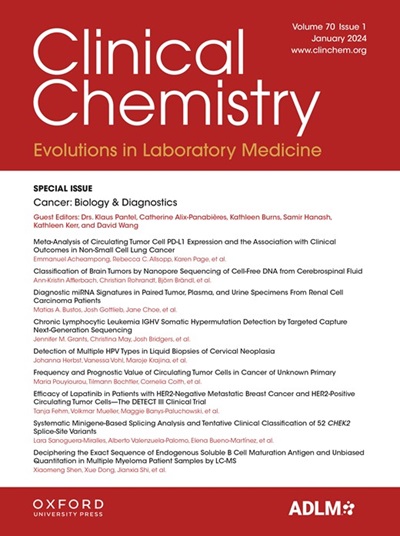B-200 为急诊室就诊的可能感染患者提供新型诊断方法,加快隐匿性败血症的鉴定速度
IF 7.1
2区 医学
Q1 MEDICAL LABORATORY TECHNOLOGY
引用次数: 0
摘要
背景 2023 年 8 月,圣母湖地区医疗中心在急诊科(ED)实施了基于新型败血症诊断(IntelliSep)的败血症护理流程。作为脓毒症学习健康计划的一部分,我们不断对这一流程进行评估。方法 由护士主导的协议允许在进行分诊评估的同时下达 IntelliSep 医嘱。根据床位情况和分诊人员对临床稳定性的评估,患者可在抽血后被转到候诊室。IntelliSep 3 级结果是一个关键值,可启动败血症路径。出现 Band 3 结果时,候诊室中的患者会被立即安置到急诊室病床上。我们通过查看病历评估了这一流程的效果和效率。结果 在 2023 年 9 月 1 日至 2024 年 2 月 7 日期间,我们共进行了 2322 次 IntelliSep 检测,其中 247 次(10.6%)在分配床位前完成,包括 124 次(50.2%)Band 1、73 次(29.6%)Band 2 和 50 次(20.2%)Band 3。这些患者分配床位的中位时间(TTB)为 104 分钟(Q1-Q3 71-180)。第 3 组的 TTB(中位数 73 分钟,Q1-Q3 58-102)明显低于第 1 组(146 分钟,Q1-Q3 86-201 分钟)和第 2 组(98 分钟,Q1-Q3 70-174 分钟),p 分别为 0.0001 和 0.01。医护人员收治了 45 名(90%)3 级患者和 62 名(50%)1 级患者(p&;lt; 0.0001)。出院诊断中,47 名 3 级患者(94%)被诊断为感染,27 名患者(54%)被诊断为败血症;686 名 1 级患者(54.8%)被诊断为感染,2 名患者(1.6%)被诊断为败血症(感染和败血症的 p &;lt; 0.0001)。结论 在分诊时实施基于 IntelliSep 的败血症诊断流程,可加快识别和治疗因隐匿性败血症而到急诊室就诊但分诊人员认为临床症状稳定的患者。本文章由计算机程序翻译,如有差异,请以英文原文为准。
B-200 Expediting Identification of Occult Sepsis with a Novel Diagnostic for Patients Presenting to the ED with Possible Infection
Background In August 2023 Our Lady of the Lake Regional Medical Center implemented a process for sepsis care based on a novel sepsis diagnostic (IntelliSep) in the Emergency Department (ED). As a component of our Sepsis Learning Health Program, we continually evaluate this process. Methods A nurse-driven protocol allows for IntelliSep ordering with triage assessment. Dependent upon bed availability and assessment for clinical stability by the triage staff, patients may be referred to the waiting room after blood draw. An IntelliSep Band 3 result is a critical value, initiating a sepsis pathway. Patients in waiting room at the time of a Band 3 result are immediately placed in an ED bed. We evaluated this process for efficacy and efficiency through review of the medical record. Results Between 01-Sep-2023 and 07-Feb-2024, we performed a total of 2322 IntelliSep tests, with 247 (10.6%) resulting prior to bed assignment, consisting of 124 (50.2%) Band 1, 73 (29.6%) Band 2, and 50 (20.2%) Band 3. The median time to bed assignment (TTB) for these patients was 104 min (Q1-Q3 71-180). TTB for Band 3 (median 73 min, Q1-Q3 58-102) was significantly lower than both Band 1 (146 min, Q1-Q3 86-201 min) and Band 2 (98 min, Q1-Q3 70-174 min), p < 0.0001 and 0.01 respectively. Providers admitted 45 (90%) of Band 3 patients and 62 (50%) of Band 1 patients (p < 0.0001). Discharge diagnosis included infection in 47 (94%) and sepsis in 27 (54%) of Band 3 patients, and infection in 686 (54.8%) and sepsis in 2 (1.6%) of Band 1 patients (p < 0.0001 for infection and sepsis). Conclusions An IntelliSep-based process for sepsis diagnosis, implemented at triage, can expedite identification and treatment of patients presenting to the ED with occult sepsis who appear clinically stable by triage staff.
求助全文
通过发布文献求助,成功后即可免费获取论文全文。
去求助
来源期刊

Clinical chemistry
医学-医学实验技术
CiteScore
11.30
自引率
4.30%
发文量
212
审稿时长
1.7 months
期刊介绍:
Clinical Chemistry is a peer-reviewed scientific journal that is the premier publication for the science and practice of clinical laboratory medicine. It was established in 1955 and is associated with the Association for Diagnostics & Laboratory Medicine (ADLM).
The journal focuses on laboratory diagnosis and management of patients, and has expanded to include other clinical laboratory disciplines such as genomics, hematology, microbiology, and toxicology. It also publishes articles relevant to clinical specialties including cardiology, endocrinology, gastroenterology, genetics, immunology, infectious diseases, maternal-fetal medicine, neurology, nutrition, oncology, and pediatrics.
In addition to original research, editorials, and reviews, Clinical Chemistry features recurring sections such as clinical case studies, perspectives, podcasts, and Q&A articles. It has the highest impact factor among journals of clinical chemistry, laboratory medicine, pathology, analytical chemistry, transfusion medicine, and clinical microbiology.
The journal is indexed in databases such as MEDLINE and Web of Science.
 求助内容:
求助内容: 应助结果提醒方式:
应助结果提醒方式:


